new posts in all blogs
Viewing: Blog Posts Tagged with: teaching tips, Most Recent at Top [Help]
Results 1 - 25 of 42
How to use this Page
You are viewing the most recent posts tagged with the words: teaching tips in the JacketFlap blog reader. What is a tag? Think of a tag as a keyword or category label. Tags can both help you find posts on JacketFlap.com as well as provide an easy way for you to "remember" and classify posts for later recall. Try adding a tag yourself by clicking "Add a tag" below a post's header. Scroll down through the list of Recent Posts in the left column and click on a post title that sounds interesting. You can view all posts from a specific blog by clicking the Blog name in the right column, or you can click a 'More Posts from this Blog' link in any individual post.
.
Howdy, Campers--Happy New Year and Happy Poetry Friday! Today's host and my (very odd) poem are below.
To start the new year--and we hope yours is copacetic thus far--we, at the brand-ndew corporate headquarters of TeachingAuthors, will each be offering a book, a tip, a tool--something which helps us read / write /create.
 |
| The new corporate offices of TeachingAuthors.com |
Ready? Hang on for the wild ride (or better: a wild
write): Esther started us off in her
post telling us about Shaun Levin's Writing Map, MY WRITING LIFE. Fascinating concept, sure to set your teeth on fire.
Today, it's my turn. As regular readers know, I've been an instructor in
UCLA Extenstion Writers' Program since the invention of goat cheese. Recently, UCLA Extension Writers' Program invited its instructors to offer a writing tip in under one minute. The videos that have been filmed so far can be viewed
here; more will be added as they're filmed, including mine--coming soon.
What's so cool about these is that when you're feeling parched, dried-out, and California-drought-ish, wondering what in heaven's name to write, or why the heck you think you
can write, simply watch one of these babies and try the tip.
I especially like
this 49-second tip by poet Rick Bursky. Could you do me a favor and watch it right now? Because what comes next assumes you've listened to him.
Okay--you've watched Rick? Thank you kindly.
So today's poem is the third draft of a poem inspired by his tip. It may not be for kids, it may not be much, but I was grabbing things from all over the internet and deep in the darkest corners of my brain, and
man was it fun to write!
CHANGES
by April Halprin Wayland
Once upon a time, there was
a train came down the track faster than it was supposed to
its feet shoulder-width apart, 90 degrees to the target
but Froggy didn't feel like getting
a lawyer for Teresa Giudice, who was freed at 5 a.m. Wednesday.
Ah, changes!
Ah, the ghastly smell of salmon which spoils so quickly in the refrigerator!
Ah, Old Dresser Redo, DIY Cloud Pillows, Easy Floating Shelves.
How we each, in our own little worlds,
carrot and stick,
the atmosphere of Mars,
water overflowing sidewalks of Hermosa Beach,
how we each change the world.
It's raining again
and there are mouse parts all over the house.
What has been your lollipop moment?
Have you thanked that person?
And they lived happily
A New, Easier Method To Use A Printer For Ink Image Transfers!
ever afterpoem (c) 2016 April Halprin Wayland. All rights reserved.
TeachingAuthors hope our tips and tools will jump-start your writing year, Dear Reader.
May this be your Year of Yes!
Watch for a related post on our Wednesday Writers' Workout on January 13th ~
posted by April Halprin Wayland with help from Eli, who was tearing up Mouse as I wrote the poem.Eli swears he didn't do it

People understand that it takes creativity to write fiction. But many don’t understand that it also takes creativity to write nonfiction. As a nonfiction author I write true stories-but they are still stories. When teaching students or teachers how to write nonfiction, I explain it like this:
I don’t create the facts,
I use the facts creatively.
Nonfiction is based on facts found in primary source documents. How an author uses those facts is what makes the difference between text that reads like a novel or a textbook. The creative part of writing nonfiction is finding a way to keep the reader turning pages to see what happens next-and at the same time telling the story accurately. To accomplish this goal, I use fiction techniques such as dialogue, sensory details, foreshadowing, pacing and all the rest.
Let’s look at just one fiction technique I use in nonfiction books: dialogue. In my books, the dialogue comes from direct quotes from documented primary sources. Teachers, students and readers can go to source notes in the back matter to see exactly where the quote was found.
I’m often asked, how do I know
when to use a direct quote,
and when not to?
I use a direct quote to accomplish one of three things:
1. To show characterization
2. To increase tension
3. To have greater impactBelow are a few examples from my books that demonstration how I used quotes as dialogue.
To show characterization:
“Kevin Turner, a former NFL player, still remembers the excitement of his high school football days. He recalls, “When I woke up on game day. I couldn’t wait until it was time for the kickoff. Wearing my jersey to school on game day was a big part of the experience. At game time, when I ran out on the field and heard the announcer call my name in the starting lineup, it was a rush, like nothing else. It was like having Christmas sixteen times a year. My parents were proud of me. Nearly everyone in our small town was cheering in the stands and spontaneously reacting to what happened on the fields. It was magical.”
To increase tension:
In this scene from
Something Out of Nothing: Marie Curie and Radium (FSG), I am showing this famous scientist at a difficult moment in her life. At the same time Curie was planning to build the Radium Institute, the shed where she and her late husband, Pierre, discovered radium was going to be torn down. I quoted Marie Curie’s own words about how she felt about visiting the shed for the last time.
“I made my last pilgrimage there, alas, alone. On the blackboard there was still the writing of him who had been the soul of the place; the humble refuge for his research was all impregnated with his memory. The cruel reality seemed some bad dream; I almost expected to see the tall figure appear, and to hear the sound of the familiar voice.”
To have greater impact:
Varian Fry, an American journalist, volunteered to go to Marseilles, France, in 1940 to rescue refugees from the Nazis. This scene from
In Defiance of Hitler: The Secret Mission of Varian Fry (FSG), is about the moment he arrives in the city. Fry wrote about this moment, so I chose to quote the entire segment exactly as he wrote it because his own words had greater impact than if I had paraphrased what happened.
“’Aha, an American,’ he said in a gravel-rough voice.
“Yes,” I said, trying to keep my voice calm.
“Marseilles is like your New York City at rush hour, eh?” he said, smiling.
I smiled back. “Quite a mob,” I said.
“Refugees. Pouring down from the north,” he said. “We would like to pour them back. But the Boches [Germans] have occupied Paris. So the refugees all run to Marseille to hide, or maybe sneak across the border. But they won’t escape. Sooner of later we arrest all the illegal ones.” He smiled again.
“Too bad for them,” I said.
“Too bad for them; too bad for us!” He gave me my passport. Enjoy your stay in our country,” he said. “But why you visit us at this unsettled time, I don’t know.”
His eyes narrowed, and I thought he looked at me suspiciously. But as I went out through the gate, I decided it was my imagination. He knew nothing of the lists in my pockets, nor did he know I had come to smuggle out of France the people whose names were on those lists.”
All three at once:
Many times, one quote like the example below accomplishes all three goals of characterization, tension and greater impact at the same time. The following section from The
Many Faces of George Washington: Remaking a Presidential Icon (Carolrhoda) shows Washington in the days leading up to the historic crossing of the Delaware.
“The Continental Army was in real trouble. At the beginning of the war, most soldiers had enlisted for short periods of time. Now that things were going badly, they left as soon as their enlistment commitment expired. At the beginning of December 1776, about half of Washington’s men went home. He knew that the enlistment for many more would expire at the end of the month. General Washington had to do something fast to raise the moral of his men, or he would soon have no army to lead. David Ackerson, one of his commanders, recalled seeing General Washington at this time saying, “he was standing near a small camp-fire, evidently lost in thought and making no effort to keep warm . . . His mouth was his strong feature, the lips being always tightly compressed. That day they were compressed so tightly as to be painful to look at.”
When writing nonfiction, when you use quotes and how you use them makes all the difference.
Carla Killough McClafferty


By:
Carmela Martino and 5 other authors,
on 9/12/2014
Blog:
Teaching Authors
(
Login to Add to MyJacketFlap)
JacketFlap tags:
Poetry Friday,
Picture Book Biography,
poem,
Book Giveaway,
writing exercise,
Teaching Tips,
April Halprin Wayland,
MFA in Writing for Children/Young Adults,
New Year at the Pier,
Barbara Krasner,
Add a tag
.
Howdy, Campers!
We have a brand new Book Giveaway for your very own autographed copy of a picture book biography (well, a real-life slice of life) of Golda Meir--just published! Details at the bottom of this post.
Happy
Poetry Friday!
Thank you,
Renee, of No Water River, for hosting today!
The link to Barbara Krasner's poem, "The Circle of Life,"
on a site which invites contributions of poetry and prose, is below ~
Today, we welcome author, teacher, blogger, historian, poet and conference organizer
Barbara Krasner into our cozy cabin for a cuppa java.
Barbara Krasner
I first met Barbara online, as she was single-handedly organizing the
Conference on Jewish Story, held this May in New York. She invited me to be on the children's panel; it was an adventure and an honor to participate.
Barbara’s interests, accomplishments and energies are unending. She began writing short stories when she should have been paying attention in SAT prep classes! She majored in German and spent her junior year in Germany. Then she spent 30 years in corporate America...but the writing bug never left her. (Can anyone relate?
Me, me!)
She's now the author of four nonfiction books, including
Discovering Your Jewish Ancestors, and more than 200 articles for adults and children that have appeared in
Highlights for Children,
Cobblestone,
Calliope, and
Babaganewz . Her short fiction and poetry have appeared in many publications and she was the semi-finalist in the 2013
Pablo Neruda Prize for Poetry.
Barbara publishes the popular blog,
The Whole Megillah ~
The Writer's Resource for Jewish Story, she's the recipient of the first-ever
Groner-Wikler Scholarship for dedication to Jewish children's literature, and is a member of the prestigious
Sydney Taylor Book Award Committee of the Association of Jewish Libraries.
Is Barbara a
TeachingAuthor? Most definitely! She earned her MFA in
Writing for Children and Young Adults from the Vermont College of Fine Arts, teaches children's literature and creative writing at
William Paterson University, and leads the
Highlights Foundation workshop, Writing Jewish-themed Children’s Books.
We’ve invited Barbara here today because her first book for children, illustrated by
Kelsey Garrity-Riley, titled
Goldie Takes a Stand! Golda Meir's First Crusade (Kar-Ben, 2014) just came out! (Kar-Ben, by the way, is the Jewish imprint of Lerner Publishing Group.)
.Mazel-tov, Barbara!
"Even at the age of nine, little Golda Meir
was known for being a leader. As the president of
the American Young Sisters Society, she organizes her friends
to raise money to buy textbooks for immigrant classmates.
It’s not easy, and when her initial plan doesn’t work,
she’s forced to dream even bigger to find a way to help her community. A glimpse at the early life of Israel’s first
female Prime Minister, this story is based on
a true episode in the early life of Golda Meir."
Welcome, Barbara! What's a common problem your students have and how do you address it?A common problem my students have is the fear of digging deep. To compensate, they produce redundant narrative that only skims the surface. I challenge them, as my mentors have challenged me, to take a deep breath and dive in.
Thank you--just reading that made me take a deep breath. Would you share a favorite writing exercise with our readers?I am a certified Amherst Writers & Artists workshop leader and I really believe in the power of writing to timed prompts. A classic prompt is to recall a photograph and begin your writing session with, "In this one..."
Another favorite is to write about something hanging on the wall in a room of your childhood family home.
I want to try those! What one piece of advice do you have for teachers?Look for the strength of each student and build on that.
 |
| Barbara Krasner ~ teaching, speaking, inspiring ~ |
What's on the horizon for you?I'm working on some Holocaust-related short stories and a couple of picture book biographies. In my master's program (
Barbara's currently a candidate for an MA in Applied Historical Studies), I am looking for ways to take my academic requirements and turn them into literary projects. A new
history book about my hometown of Kearny, New Jersey is an example of this. I am promoting my picture books this fall, such as my
"What Would Goldie Do?" program at Jewish community centers (JCCs) and synagogues. I also hope to be teaching
Writing Your Family History at my local JCC.
WOW, Barbara! And since it's Poetry Friday in the Kidlitosphere, do you have a poem you'd like to share with our readers?Here's a link to my poem,
The Circle of Life on The Jewish Writing Project site, which invites contributions of poems and more.
(Readers, this site is well worth exploring and includes, among other things, a terrific
page of questions and writing ideas for kids)
We'll close with a preview of Goldie Takes a Stand! (enter for a chance to win it below):
Thank you so much for coming by today, Barbara!
Book GiveawayEnter for a chance to win an autographed copy of Goldie Takes a Stand! This giveaway ends on September 26.Use the Rafflecopter widget below to enter via 1, 2, or all 3 options specified. If you choose the "comment" option, share a comment to today's blog post about your experience with writing or teaching historical fiction. And please include your name in your comment, if it's not obvious from your comment "identity." (If you prefer, you may submit your comment via email to: teachingauthors [at] gmail [dot] com.)If you've never entered a Rafflecopter giveaway, here's info on how to enter a Rafflecopter giveaway and the difference between signing in with Facebook vs. with an email address. Email subscribers: if you received this post via email, you can click on the Rafflecopter link at the end of this message to access the entry form.Good luck!a Rafflecopter giveaway
"Trust yourself. Create the kind of self that you will be happy to live with all your life. Make the most of yourself by fanning the tiny, inner sparks of possibility into flames of achievement." ~ Golda Meir
But
wait ~ there's more! Barbara's
Goldie Takes a Stand! will soon be followed by a Holocaust picture book,
Liesl's Ocean Rescue (Gihon River Press, Fall 2014).
posted by April Halprin Wayland
p.s: It's nearly New Year's and my picture book, New Year at the Pier (Dial), winner of the Sidney Taylor Book Award for Younger Readers, celebrates the ritual of Tashlich, a wonderful, seaside gathering during the Jewish New Year (which begins September 24th and ends September 26th this year.) 

By:
Carmela Martino and 5 other authors,
on 9/27/2013
Blog:
Teaching Authors
(
Login to Add to MyJacketFlap)
JacketFlap tags:
Interview,
Poetry Friday,
Nonfiction,
poem,
Book Giveaway,
Teaching writing,
children's poems,
Teaching Tips,
Alexis O'Neill,
book raffle,
April Halprin Wayland,
Janet S.Wong,
Rafflecopter,
Add a tag
.
Howdy Campers and happy Poetry Friday!
See the end of this post for a link to the Poetry Friday round-up at Amy LV's and for info on our Book Giveaway.
Today we're celebrating author Alexis O'Neill's newest book with Book Giveaway! Hark! Here comes Alexis now:
Yes, that's Alexis wearing the crown--and she deserves it as the author of
THE RECESS QUEEN (Scholastic),
THE WORST BEST FRIEND (Scholastic),
LOUD EMILY (Simon and Schuster),
ESTELA'S SWAP (Lee
& Low) and her newest offspring,
THE KITE THAT BRIDGED TWO NATIONS:
Homan Walsh And The First Niagara Suspension Bridge
(Calkins Creek). She's also written fiction and nonfiction for
Cricket, Spider, Cobblestone, Calliope, Faces, and
Odyssey.
I've known Alexis since
Janet Wong founded the
Children's Authors Network (CAN!) during the classical era of the children's literature movement.
Alexis is an absolutely amazing teacher. In one memorable workshop, she taught CAN! authors how to create and present teacher inservices. It was an extraordinary presentation and it formed how I respond and present to teachers to this day.
Alexis has golden credentials in the field of education: she's a former elementary teacher with a Ph.D. in teacher education, she's an instructor for the
UCLA Extension Writer’s Program, a museum education consultant, a
Regional Advisor for SCBWI in California, and a contributor to the
SCBWI Bulletin, writing her column, “
The Truth About School Visits.” Her blog,
www.SchoolVisitExperts.com, offers practical advice to published authors and illustrators who are trying to navigate the world of public appearances.
This August, she was named
SCBWI Member of the Year --and though it was a complete surprise to her (though to no one else), she sang a sea shanty as she accepted the award.
Because that's who Alexis is--generous, original and dramatic. It's as if her goal is always to bring the classroom, the auditorium, fellow authors--whoever is around--together. As if she is a shepherd and we are the community she's teaching and keeping safe.
This is Alexis, keeping us safe.
Her new book,
THE KITE THAT BRIDGED TWO NATIONS: HOMAN WALSH AND THE FIRST NIAGARA SUSPENSION BRIDGE (Calkins Creek, September 2013) tells the true, dramatic story of how an ordinary boy earned an extraordinary place in history, using his kite to lay the first line for the first suspension bridge at Niagara Falls in the winter of 1848. Watch this 1:42 minute book trailer for a taste of the book:
So, Alexis, how did you become a TeachingAuthor?
I’ve been a
TeachingAuthor all my life! As a kid, I convinced my dad to hang a blackboard in the garage and persuaded the neighborhood kids to sit in my “class.” After school, I wrote (and sold) a neighborhood newspaper which I composed on my mom’s portable typewriter. As a grown up, I’ve taught elementary school students, teacher education candidates, and, as a published author, writers.
What's a common problem/question that teachers or students have and how do you address it?
Students of all ages are so afraid of being “wrong.” My advice to them is to just play with words! Don’t worry about what other people think of your work. Can’t find a word? Make it up! Or make a mark to come back to that spot later. Just mess around, and in that mess, you might find the seed of an idea that can sprout into a full-blown piece of writing that you will want to share later on. To address this problem when we do writing exercises, I tell students up front that no one will collect their writing – and that they can decide when and what they will share with the group.
Was there a moment in your life when you knew you were a writer?
The moment I knew I was a writer was when my sixth grade teacher read my report on Ireland out loud to the class. Instead of a dry, factual presentation, I had “pretended,” in my narrative, to be a tour guide who was taking the whole class with her on a trip. First, I was surprised that he read it out loud, then I was really surprised when, at recess, my classmates came up to me and said how much they liked what I had written. That’s when a big light bulb went on over my head. “Wow! I can write for an audience, and not just for my teacher!” I thought.
From that moment on, I made all of my reports as creative as possible. For example, my report on the Alamo was told from the point of view of the only survivor (there were none in reality, but that didn’t stop me.) Now I know I was writing historical fiction. But I kept doing this, and teachers kept reading my work out loud in my classes. The birth of a writer – writing for an audience and not just for a grade from my teachers!
And finally, since it's Poetry Friday in the Kidlitosphere, do you have an original poem you'd like to share with our readers?
THE FALLS
by Alexis O'Neill
I am thunder and roar
I am rain and river
Green and white magnificence.
You try to tame me
and you fail.
In barrel and boat
I spin you,
plunge you
crush you,
drown you.
A filmy fairy curtain?
Not I!
A lacy veil?
Not I!
I gnaw at rock
bite through cliffs
claw the very bed
across which I race
oceanward.
Out of my way!
I am the great Niagara
poem © 2013 Alexis O’Neill. All rights reserved
Wow--what a powerful waterfall of words! Thank you for stopping by and thank you for offering our readers a chance to win a copy of your new book (details below), Alexis!
Here's a peek at Alexis's touring schedule for A Kite that Bridged Two Nations. Be sure to visit her at AlexisONeill.com, follow her on Twitter, and friend her on FaceBook.
And now, for the Book Giveaway details:
We use Rafflecopter. If you've never entered a Rafflecopter giveaway, you may want to read their info on how to enter a Rafflecopter giveaway and/or the difference between signing in with Facebook vs. with an email address.
To enter for a chance to win an autographed copy of The Kite That Bridged Two Nations log into Rafflecopter below (via either Facebook or an email address). You'll see that we've provided three different options for entering the giveaway--you can pick one or up to all three.
The more options you choose, the greater your chances of winning. While
we haven't made it a requirement for entering, we hope that everyone will WANT to subscribe to the TeachingAuthors
blog. We give you several ways of doing so in the sidebar, for example,
via email, Facebook Networked Blogs, Jacketflap, Bloglovin', etc.
If you're already a TeachingAuthors subscriber, you need only click on the first option below and tell us how you follow our blog, which will give you THREE entries in the giveaway! (If you received this post via email, you can click on the Rafflecopter giveaway link below to enter.)
As it says in the "Terms and Conditions," this giveaway is open to U.S. residents only.
You must be 18 or older to enter. And please note: email addresses will
only be used to contact winners. The giveaway will run from now through October 9, 2013.
If you have any questions about the giveaway, feel free to email us at teachingauthors [at] gmail [dot] com.
a Rafflecopter giveaway
Posted by April Halprin Wayland with help from the Link Fairy.

By:
Carmela Martino and 5 other authors,
on 5/8/2013
Blog:
Teaching Authors
(
Login to Add to MyJacketFlap)
JacketFlap tags:
April Halprin Wayland,
writer's prompts,
Beck McDowell,
Wednesday Writing Workout,
Blogiversary,
writing prompt,
writing exercise,
newspapers,
Teaching writing,
Teaching Tips,
Add a tag
.
Howdy, Campers!
Before we get to today's Wednesday Writing Workout, I wanted to share author and bookseller Elizabeth Bluemle's latest post on her Publishers Weekly blog, ShelfTalker. It moved me. It's called "The Best Author Letter Ever."
Yes, Virginia, we--authors and teachers--can change a child's life. Here ~ in case you need to dry your eyes:
And now, on to today's
Wednesday Writing Workout! But first some background:
Last month I was fortunate to participate in the beautifully organized
Fay B. Kaigler Children's Book Festival in Hattiesburg, Mississippi...
April Halprin Wayland, Robyn Hood Black, and Irene Latham
play with food poems for their panel,
“Take Five! Create Fun with The Poetry Friday Anthology"
photo by Beck McDowell
...where I met the wonderful
Beck McDowell,
Author Beck McDowell
...author of the eerily timely novel,
This is Not a Drill (Penguin), published just a few weeks before Sandyhook.
Beck gives us today's
NEWSPAPER STORY STARTERS
1) Give this exercise about 20 minutes.
2) Divide the class into groups of two or three.
3) Let them choose newspapers and magazines from a stack you've brought in.
4) Their job will be to select a news article and make up their own story using the article as a starting point. They'll add characters, twists, etc. to create an even more engaging story.
4) Each group elects a spokesperson. The spokesperson shares a two-to-three minute synopsis of the "story" they've outlined, beginning with what the article actually said so everyone knows their starting point and how the group changed it.
Beck says, "...
you're demonstrating where ideas come from and how a real event can trigger a story idea that's ultimately totally different from the original."
Thank you, Beck!
Monkey combs his favorite paper for story ideas
P.S: My
Writing Picture Books for Children class in the UCLA Extension Writers Program (which I've taught since 1999) started this week. I hope to use the newspaper exercise in class this quarter. Let me
know how it works! And if you have any suggestions on how to make it more effective, my students will be most grateful--
please take a moment to scribble a comment!
Finally, don't forget: there's still time to enter our blogiversary
giveaway for a chance to win one of four $25 gift cards to Anderson's
Bookshops.
See this post for details.
And after you've entered, take five minutes and do a free write. Remember to breathe...and to write for the fun of it ~
picture of Monkey and drawing of dancer by April Halprin Wayland.
posted by April Halprin Wayland 

By:
Carmela Martino and 5 other authors,
on 9/23/2011
Blog:
Teaching Authors
(
Login to Add to MyJacketFlap)
JacketFlap tags:
poetry exercise,
poetry prompt,
Poetry,
Poetry Friday,
Book review,
Contests,
Book Giveaway,
Jane Yolen,
Nikki Grimes,
Teacher Resources,
Teaching Tips,
April Halprin Wayland,
Guest Teaching Author,
Add a tag
~
Howdy, Campers--Happy Poetry Friday!
Nikki's accumulated more honors, and has written more books and more articles than we have space to list, but it's too interesting not to mention that she's also a performing artist, a fine artist, a fiber artist, a jeweler and more...as she says, she's a Jane-of-all-Trades. I've known Nikki for a long time and have always been moved by her unfailing generosity. Toda
by Amy M. O’Quinn

Lapbooks are very popular in many homeschooling/educational circles, and for good reason. Children who create something tangible after reading a particular book or learning about a certain topic are far more apt to retain that knowledge. It is motivating to be able to hold in their hands or ‘on their laps’ their very own special reminder of their learning experience. Besides that—creating a lapbook is fun, and the educational and enjoyment possibilities are endless! However, for today, I will concentrate solely on lapbooks that are related to children’s literature and timeless picture books!
What Exactly Are Lapbooks?
Lapbooks can be as complex or unique as the fingerprints of those who make them! But the general definition of a simple lapbook is a single manila folder refolded and creased in such a way as to form a small, portable ‘learning center’ that can be opened and filled with mini activities, games, reports, charts, pictures, flip books, etc. inside that are created by the students themselves as they learn about the topic(s). In other words, a lapbook is a type of graphic organizer.
Families who enjoy scrapbooking will find lapbooking to be a perfect way to enhance learning—but anyone can create a lapbook that is interesting, fun, and effective. In addition, a lapbook can the organizer to pull together relevant topics from many subject areas—all based on one particular book.
Below is a lapbook we created based on the book The Little House by Virginia Lee Burton. Many of the printables were found at www.homeschoolshare.com

Resources/Books About Lapbooking
Hear are a few websites and books that have great tutorials or information on how to create lapbooks:
Homeschool Mom- Lapbooks (Many links to other sites filled with lapbooking information.)
Templates by Homeschool Share
Lapbooks by Homeschool Share
*Homeschool Share (HSS) is an on-line cooperative effort of several homeschooling moms to provide free but quality literature-based unit studies and resources. The content on this site is
unbelievable!
Lapbooks to Enhance the Learning Experience by Lynda Altman at Bright Hub
Ms. Altman includes information on how lapbooks can be used in the classroom and at the high school level.
Fundamentals of Lapbooking by Carrie Kerr at Bright Hub
This is another article showing how lapbooks can be used in the classroom.
Lapbooking for Everyone at Easy Fun School—This site includes lots of lapbooking links.
Lapbooking at Squidoo
A Journey Through Learning Lapbooks and Unit Studies (Literature Lapbooks)
Dinah Zike at
0 Comments on Literature Lapbooks as of 1/1/1900
by Amy M. O’Quinn
The Statue of Liberty! One of America’s most well known landmarks, Lady Liberty has stood on her own island in the New York Harbor just southwest of Manhattan Island since 1886, and she has welcomed countless visitors and millions of immigrants to a new life in a new country. She has witnessed changes, joys, and even heartaches—yet she has stood the test of time and continues to be a beacon of hope and a representation for freedom for all Americans.

Did You Know?
Almost everyone knows that the Statue of Liberty was a gift from France to celebrate the friendship between the two countries and their common quests for freedom. But did you know that the French sculptor, Frederic Auguste Bartholdi, originally had the concept of placing the statue of a woman at the opening of the Suez Canal? Did you know that the Statue of Liberty functioned as a lighthouse from 1886 to 1902? Did you know that Lady Liberty’s right arm and torch were on display in Madison Square Park for six years while efforts to raise money to finance the statue and base? Did you know that the statue’s complete name is Liberty Enlightening the World?
Lady In Green
Here’s another neat fact. The Statue of Liberty is actually made of copper, but over the years hydrogen, oxygen, and carbon atoms from various substances in the air have combined with the copper atoms in the statue to make copper hydroxycarbonate (From Exploring Creation With Physical Science by Jay Wile). In other words, the copper has oxidized, and this chemical reaction has created a nice patina—or a green coating on the statue.
Changes
Trivia about the history of this famous landmark and statue statistics of the Lady are vast. Surprisingly, I experienced firsthand one of the changes the Statue of Liberty underwent back in 1984. When my high school classmates and I went to Washington and New York for our Junior-Senior trip, we were unable to disembark from our ferry onto Liberty Island and visit the statue because she was closed for repair and renovations. All of our photos showed the Lady from afar, encased in scaffolding. And although we were disappointed, we knew we were also witnessing a piece of history we would never forget! The Statue of Liberty National Monument reopened in 1986.
The Statue of Liberty was also closed after the 9/11 attacks in 2001. The monument reopened in 2004, and the crown and interior finally reopened last year (2009) on July 4th.
Resources About the Statue of Liberty
For a family activity, study the history and significance of the Statue of Liberty and the importance of her role in American culture. Below are some website/book suggestions:
Statue of Liberty National Monument website
Essential Big Apple: Statue of Liberty

The Statue of Liberty (Step Into Reading series) by Lucille Recht Penner
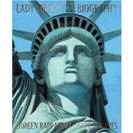
Lady Liberty: A Biography by Doreen Rappaport
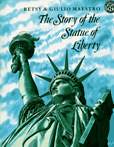
The Story of the Statue of Liberty by Betsy Maestro
 0 Comments on A Look at Lady Liberty as of 1/1/1900
0 Comments on A Look at Lady Liberty as of 1/1/1900
by Amy M. O’Quinn

Picnics, parades, patriotism and fireworks are on everyone’s mind as the Fourth of July approaches, and Americans everywhere will proudly fly the Stars and Stripes to commemorate our country’s quest for independence and freedom!
Yes, Old Glory will definitely be the star of the show in July since it is America’s most well-known icon, but there are many more symbols that represent this great country of ours as well—the Statue of Liberty, the White House, the U.S. Capitol, the Liberty Bell, Mount Rushmore, the Great Seal of the United States, the Bald Eagle, etc. We can also include the Declaration of Independence, the Constitution, the Bill of Rights, the Pledge of Allegiance, our National Anthem, the Supreme Court, and of course, Uncle Sam. The list goes on and on, but how many historic American symbols, landmarks, documents, songs, or organizations can your children name? How many can YOU name?
Do You Know. . .
How much do you really know about the Great Seal of the United States? According to information on the Great Seal website, America needed an official symbol of sovereignty to seal and authenticate her international treaties and transactions. The new nation needed a symbolic signature others would recognize and honor. Thus, the Great Seal was created in 1792, the mid-way point between the Declaration of Independence and the Constitution.
Here is a bit of Mount Rushmore trivia from the Mount Rushmore National Park website. Did you know that the monument designer originally put Thomas Jefferson on George Washington’s right, but after eighteen months of work, he changed plans, dynamited Jefferson off the mountain, and placed him on the left? Did you know that Teddy Roosevelt, the most controversial choice on Mount Rushmore, had died only eight years before work on the monument began?
Find Out!
For a fun family project, why not explore and research American’s symbols and landmarks to learn more about these famous icons and why they are so important in our country’s history?
To get started, check out Capstone’s Picture Window Books series on American symbols. A few of the titles include:
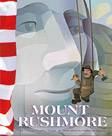
Mount Rushmore by Thomas Kingsley Troupe

Our American Flag by Mary Lynn Firestone
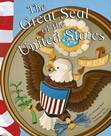
The Great Seal of the United States by Norman Pearl
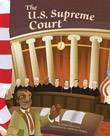
The U.S. Supreme Court by Anastasia Suen
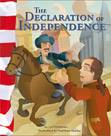
The Declaration of Independence by Lori Ann Mortensen
Dig into America’s past, and you might just be surprised to discover many fascinating facts you never knew!
 <
<
By Kathy Stemke
Need to keep your young children occupied this summer? Well, most kids love dinosaurs. Here are some great dinosaur books with some activities you and your children will love!

“Dinosaurs” That Swam and Flew. By David C. Knight
1. Great outdoor activity-get a basin full of water and a small tree or bush. Trace and make sponge dinosaurs from the book. Using sponge dinosaurs, swim, or fly each one inTO their habitat. (water, flying-onto a tree)
2. Tell students to use the names of dinosaurs to create new names for foods (Rhamphorhynchus raisins, Plesiosaurus pizza, Apatasaurus asparagus). Then have them write a menu for lunch using these “new foods”. Allow time for students to share menus. Plan a Dinosaur lunch for the entire class. Have students sign-up to bring some of the “new foods” from home.
3. Everyone sings this song, one child acts as the dinosaur, and all the others do the moving away actions.
(tune: I Wish I Were an Oscar Meyer Wiener)
Oh I want to be a giant grumpy Dino,?
That is what I really want to be!?
For if I were a giant grumpy Dino,?
Everyone would run away from me. . .?
Ahhhhhhhh!!!!!!!!??
Additional Verses:
jump away from me
crawl away from me swims away from me
flies away from me
Dinosaurs and Their Young by Russell Freedman
Bones, Bones, Dinosaur Bones by Byron Barton
1. Dino egg match-From a dollar store buy adult size dinosaurs, plastic eggs, and tiny dinosaurs. Put the tiny dinosaurs into the plastic eggs. Place the adults in a line with their names displayed. Each child opens an egg and matches it to its mother. Between each turn name all the dinosaurs.
2. Make a movie of the four stages of a dinosaur’s existence (egg, adult, dig up bones, put them in a museum).
Dinosaurs by Kathleen Daly
1. Have students take on the role of a particular dinosaur. If possible, mime the dinosaur, in addition to giving out one clue at a time: I weigh __________. I am __________ tall. I eat __________ . Allow four clues. If students haven’t guessed the dinosaur after four guesses, have the dinosaur-student provide the answer.
2. Provide students with plastic dinosaur figures, clay, dinosaur model sets, and so on. As a class, create a display or diorama that depicts a prehistoric time when dinosaurs roamed the world.
If the Dinosaurs Came Back by Bernard Most
1. Cut out a dinosaur and, using it as a pattern, make pages and construction paper covers for student dinosaur books. Allow students to use these materials to write their own stories about “if dinosaurs came back.” Provide time for the students to share their stories.
2. Write a letter to one of the dinosaurs in the story saying why you would like it to come back or why you wouldn’t.
3. List some dinosaurs and their lengths on the chalkboard. To help students understand how long the different dinosaurs were, measure their exact lengths with a ball of yarn (in which you have previously tied knots every 5 feet). Count by fives as the yarn is unrolled. Use a meter stick to convert these lengths to meters.
Dinosaur Dig by Kathryn Lasky
1. Have students become paleontologists (a scientist who specializes in finding and studying ancient fossil remains) by bringing clean chicken bones to school. Place each bone in wet, packed sand to make an imprint. Remove the bone and pour plaster of Paris into the imprint (or mold). Let it harden and then remove it from the sand. Have students label and display their fossils.
by Amy M. O’Quinn
Children love the unusual! So why not surprise them with a science exploration after dark?
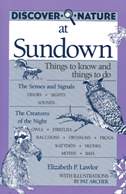
Discover Nature at Sundown by Elizabeth P. Lawlor
There are all kinds of enjoyable learning opportunities just waiting in the shadows, and everyone will have fun—all while experiencing the nocturnal side of nature!

Time for Kids: Spiders by the Editors of Time for Kids
Spiders, especially wolf spiders, are very common and easy to spot in your yard at night. According to the experts at the Arizona-Sonora Desert Museum, the spiders have a green ‘eye shine’ that is caused “by a tapetum in the eye which reflects light rays back through the eye retina and probably enhances the spider’s night vision.” For a neat activity, use a flashlight or small light that straps around the forehead and walk slowly through your yard, casting the beam towards the ground. You will be amazed at all the beautiful jewel-like glitters you’ll see. These are actually the spiders’ eyes! Shine the light closer to the ‘glitters’ and you’ll probably find a spider. Is it a wolf spider or some other kind? Find out!
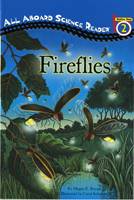
Fireflies by Megan E. Bryant
Fireflies or lightning bugs are fascinating creatures that sparkle and flicker in the summer woods. Light production in fireflies is due to a type of chemical reaction called bioluminescence, and the bugs light up to attract a mate. For a fun activity, catch and place several fireflies in a jar with a mesh top for a few minutes. Children love to examine these extraordinary insects and are captivated and delighted by their ability to produce cold light. Discuss the phenomena of bioluminescence before gently releasing the fireflies.
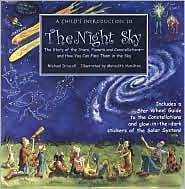
A Child’s Introduction to the Night Sky: The Story of the Stars, Planets, and Constellations–and How You Can Find Them in the Sky by Michael Driscoll
Few things are lovelier than a clear night sky filled with twinkling stars. In addition, studying the heavens with a young stargazer makes for a priceless memory. Although there is a plethora of scientific information concerning navigation, the atmosphere, telling time by the stars, mythology, or seasonal changes that would be interesting to pursue, simply looking upward at the stars and finding constellations or ‘pictures in the sky’ is a pleasurable pastime. How many constellations can you identify? Check out a book or find a relevant website and start gazing at the stars.
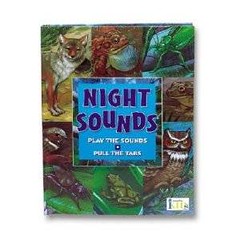
Hear and There Book: Night Sounds by Frank Gallo
Whooo, whooo do you hear hooting or calling out in the night? Owls, spring peepers, frogs, crickets and katydids all make interesting sounds that are fun to identify. As you walk around outside in the evening, do you hear noises that are familiar? Now, listen really hard. Do you hear animal calls or sounds that you may not have noticed before? Find out what they are and read about the insect or animal you have identified!

Forest Bright, Forest Night by Jennifer Ward
Exploring at night is an awesome way to generate enthusiasm, creativity and a love of the outdoors. While in the dark, you might jus
by Amy M. O’Quinn
Children learn by doing! This age-old maxim is certainly true, and the theory works in the kitchen as well as in the classroom. Almost all children, especially when they are young, enjoy helping their parents cook and dish up yummy culinary delights. Yes, it can be messy. Yes, you could probably do the job in a fraction of the time without little helpers underfoot. However, consider the rewards of letting your kids don an apron and wield a whisk:
1. First and foremost, children learn about teamwork and how to follow directions. And most importantly, you are not just creating meals together—you are creating memories!
2. Children learn about safety and cleanliness, but they also learn about good nutrition. With childhood obesity becoming an ever-growing epidemic, children need to be exposed to healthy foods and habits.
3. Surprisingly, many young adults do not know their way around a kitchen. Children who learn important culinary skills at a young age are already one-step ahead of the crowd. Cooking is a life skill that will pay off big dividends in the years to come. Learning how to be self-sufficient is also a big booster to self-confidence. Moreover, learning how to chop, stir, mix, roll, pour, and cut, etc. develops fine motor skills and hand/eye coordination.
4. The kitchen is a classroom!
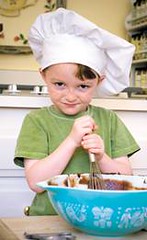
Below is a list of just a few educational things children learn while cooking:
History: Many families heartily embrace their culture and heritage, and learning to cook ethnic foods that the family has enjoyed for generations is a way to connect the present with the past, while ensuring knowledge for the future. Children can also learn about the history and origin of various other foods as well. In essence, cooking is universal.
Science: Cooking is really a science in itself. Children will learn first-hand about chemical reactions, how temperature affects food and cookware, what ingredients will combine well and those that will not. They also learn about the different food groups and how to classify. In addition, the five senses will get a good workout as the children learn about eye-appealing colors and combinations, or tastes/smells such as sweet, salty, bitter, bland, sour, pungent, sharp, and textures such as smooth, rough, grainy, soft, etc.
Math: Many parents discover that cooking is a great way to teach fractions, measuring, weighing, ordinal numbers, counting, geometrical shapes, symmetry, etc.
Creativity/Art: When children are allowed to experiment and try new skills in the kitchen, they develop creativity. An appreciation for pleasing colors, composition, and presentation is also fostered. Who knows, you might just be training a future chef, baker, or food artist.
Reading/Literature: Studying a recipe definitely enhances reading skills and comprehension and emphasizes the importance of following directions. But there are also many ways to incorporate great literature while learning to cook. For example, after reading Homer Price, make doughnuts. How To Make An Apple Pie and See the World is a great lead-in for baking pies. The Duchess Bakes A Cake might inspire cake baking and learning about yeast. And the Little House on the Prairie books definitely inspire learning about good old-fashioned vittles and down-home cooking. It might also be fun to plan a ‘theme’ meal and use relevant recipes and cooking skills to prepare for a special memory-making occasion. The ideas are endless!
Here are a few more suggestions for books that lend themselves to cooking activities, but you can find a whole list of books that contain recipes at Cooking Up Reading:
-Cloudy With A Ch
by Amy M. O’Quinn
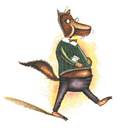


Good readers get the big picture. They comprehend the meaning of the text and better understand what the author is trying to convey. In addition, learning to identify a character’s point of view in a simple picture book or story is a great way to introduce children to an important aspect of being a good reader.
It will also prepare them for heavier literature when they get older when identifying a character’s point of view is vital to understanding the plot and the underlying meaning or theme of the story. It is a skill to develop through the years, and having a basic working knowledge of this device will also help students learn about the first person, second person, third person, omniscient, and limited omniscient points of view as they mature as readers and writers.
Point of View (POV):
POV is simply the standpoint or position from which the reader gets to observe, consider, or ‘hear’ the story. For this particular article, I would like to concentrate on a first person narrative POV from a well-known children’s story.
A Simple Way To Teach POV:
Almost everyone knows the story of The Three Little Pigs and the Big Bad Wolf. The pigs are the victims and the wolf is the villain. We ‘hear’ the story from the viewpoint of the three little pigs, and we feel sorry for them—right down to the hairs on their chinny-chin-chins! The wolf is a mean, evil character, and we are happy to see justice served in the end. Obviously, he deserves what he gets!
So gather your students around and read the traditional story of The Three Little Pigs. Or have them act out the story with parts—using appropriate voices and simple costumes if possible. My children always use a high, squeaky voice for the pigs and a low, growly voice for the wolf. Discuss the elements of the story and the perspectives of the characters. Who is ‘good’ and who is ‘bad’? Who is right and who is wrong? How did the pigs feel and react when the wolf came to each of their doors?
A Twist:
But what if there is a chance that the traditional tale we all know and love might not be the ‘real’ story! What if the wolf has a different version of the story to tell? What about his POV?
The True Story of the Three Little Pigs:
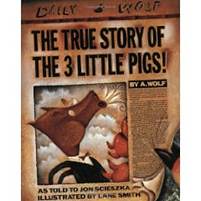
Here is where the fun begins! Purchase or check out Jon Scieszka’s hilarious book, The True Story of the 3 Little Pigs from your local library and read it to the students. As Alexander T. Wolf, the narrator, tells his audience on the very first page:
“Everybody knows the story of the Three Little Pigs. Or at least they think they do. But I’ll let you in on a little secret. Nobody knows the real story, because nobody has ever heard my side of the story.”
Of course, in this version, we hear from Alexander T. Wolf. He claims that he had a cold and all that he wanted to do was borrow a cup of sugar from one of his neighbors when all the trouble began. According to him, he was framed!
Now discuss the differences in the two stories and the POVs. Compare and contrast. Make a comparison chart if possible.
The Verdict:
So who is telling the truth, the pigs or the wolf? Who is more believable? Why? Should Alexander T. Wolf have been
by Amy M. O’Quinn
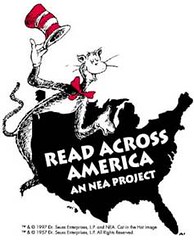
The more that you read, the more things you will know. The more that you learn, the more places you’ll go.
~Dr. Seuss
Mark your calendar for March 2nd! Why, you may ask? Well, at our home we will celebrate my daughter’s tenth birthday on that day. But other children across America will also be celebrating the birthday of beloved author, Dr. Seuss, as well as participating in ‘Read Across America’, sponsored by the National Education Association.
What is Read Across America?
In 1997, a small task force at NEA came up with the big idea to set aside one day to really celebrate reading and motivate children across the country to pick up a book and read. They wanted the whole event to be exciting and inspiring—and to promote a love of reading. The task force also decided that March 2nd, the birthday of Theodor Seuss Geisel (better known as Dr. Seuss) would be the perfect date. Thus, ‘Read Across America’ was born, and the first annual celebration was held on March 2, 1998.
According the NEA website, “Motivating children to read is an important factor in student achievement and creating lifelong successful readers. Research has shown that children who are motivated and spend more time reading do better in school.”
How does it work?
Although the NEA created and sponsors ‘Read Across America,’ teachers, parents, librarians, bookstore personnel, and other community volunteers at the local level organize and implement all kinds of exciting events to celebrate reading and get children involved in special literacy activities. There are many great ideas on the NEA/RAA website, as well as state educational association websites. The possibilities are endless.
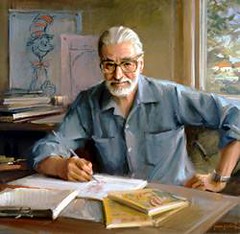 Dr. Seuss (1904-1991)
Dr. Seuss (1904-1991)
What child doesn’t love a Dr. Seuss book? The rhythm and rhyme are delightful, and everyone has a favorite. My children enjoyed all the Dr. Seuss books, but they especially liked Green Eggs and Ham, Mr. Brown Can Moo, Can You? and The Cat in the Hat. In fact, they can all recite most of Green Eggs and Ham from memory. Would you? Could you?
When we first began homeschooling, I quickly discovered that Dr. Seuss books were perfect for oral reading practice to enhance fluency. The children loved the nonsensical language, yet they were able to experience reading success because of the simple words, repetition and familiarity of ‘old friends’ they’d known for years. Beginning readers need to feel successful; it motivates them to keep learning. Plus, the stories written by Dr. Seuss are just plain fun, and everyone needs a good giggle or chuckle from time to time.
How Can You Be Involved in Read Across America?
There are events and activities scheduled all over the country—in large cities and small communities. Chances are, the local school system, your child’s teacher, or your neighborhood librarians have already planned some special things for March 2nd. Visit the NEA website or your state educational association to find some fabulous fun near you. Perhaps you may even decide to volunteer or help organize some events.
If you have preschool children or are a homeschooling parent, you can also plan some activities to do with your child at home. Although we advocate reading ALL year long, it is still fun to have a special day to do something just a little bit different.
A Few Simple Ideas:
-Read Green Eggs and Ham—then MAKE green eggs and ham. Add a
 by Sharon Blumberg
by Sharon Blumberg
Here’s a prewriting activity I’ve used in my language arts classroom when students get tired of traditional book reports. I have students write a book about themselves. First, they answer the following questions to create an autobiographical character sketch. Later, each student can use his character sketch to create his “book” – which is the story of his life.

Questions to Create Autobiographical Character Sketches
If someone were to read a book about you, what would be the title? ________________________
List three interesting facts about yourself. ____________________________________________
What is your most important accomplishment at this point in your life? ____________________
Create a timeline of the most important events in your life.
______________________________
Please write a paragraph explaining how the world would be different without your life accomplishments, at this point in time? ______________________________________________
What kinds of hobbies and interests make you unique? __________________________________
What are the strength and weaknesses that make you unique? ____________________________
In what kind of setting would a story of your life take place? _____________________________
Who would be the major characters in your life story? __________________________________
What would be the plot and major conflict in your life story? _____________________________
What would be the climax and resolution of your own life story? __________________________
What point of view would your life story be told from? _________________________________
by Kathy Stemke
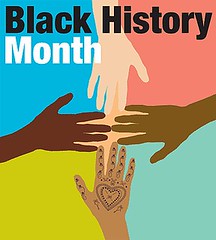
Black History Month is a time to create greater awareness of a strong and powerful culture with a rich history. The following books and activity ideas will keep children engaged as they learn about inspiring black Americans and their culture.
Bestselling and award-winning author, HYPERLINK Nancy I. Sanders has published over 75 books including A Kid’s Guide to African American History and D is for Drinking Gourd: An African American Alphabet.
Her new book is America’s Black Founders, for ages 9 and up. Through the petitions they wrote, the sermons they preached, the literature they published, the churches they built, and the organizations they formed, African Americans influenced the birth of a new nation in powerful and far-reaching ways. Click here for several activity ideas from Nancy’s websiteClick here for several activity ideas for Black History month from Nancy’s website.
Ella Fitzgerald: The Tale of a Vocal Virtuosa is an excellent example of a quality book that conveys black history in kid-appealing way. Ella’s story is told through the perspective of a cat, “Skat Cat Monroe,” who pulls in readers in with rhythm and rhyme.
LANGUAGE ARTS ACTIVITIES
Use words from this story to practice finding the number of syllables in words. How many syllables are in Skat? Fitzgerald? determination?
Have students look up words from the story in the dictionary and share reports either written or verbal. Let students determine alphabetical order of the words.
MATH ACTIVITIES
We learn in A Note From the Author that Ella was born in 1917. The story tells us that in 1935 the Harlem Opera House signed Ella as a featured singer. How old was Ella?
We learn in the story that Ella and Dizzy Gillespie headlined a sold-out performance at Carnegie Hall in 1947. If she was born in 1917, how old was Ella in 1947?
We learn in A Note From the Author that Ella died in 1996. If she was born in 1917, how old was Ella when she died?
MUSIC & MOVEMENT ACTIVITIES
“A-Tisket, A-Tasket” was a hit song sung by Ella Fitzgerald that began as a “jump rope jive.” Jumping rope is an excellent work out and helps children develop timing and balance. Have your students jump rope along to Ella’s music and encourage them to create their own jump rope songs.
Dizzy by Jonah Winter features the famous Dizzy Gilliespie.
VOCABULARY ACTIVITIES
There are many instruments featured in the illustrations of Dizzy. Passing the book around, make a list of the instruments your group can identify. There’s a trumpet, sax, French horn, bass, piano and drums. Now brainstorm to create a list of instruments not featured in this book.
MATH ACTIVITIES
Review the music math words for solo, duet, trio, quartet and quintet. Call students up with instruments in singles and small groups and let the group name the band with these math music words.
ART & MUSIC ACTIVITIES
Painting to the Beat: Provide paper, watercolor paints and space for each child to paint. Play one of Dizzy Gilliespie’s many CDs that are available at your local library. Encourage children to paint to the beat. Ask them to consider what “color” a song feels like. Be sure to have them write the title of the song, along with their name and date on their musical masterpiece.
MOVEMENT ACTIVITIES
A Jazz Parade: Provide children with handmade instruments or objects with which they can create a beat. Turn on the music and ha
by Amy M. O’Quinn
To continue with my series on introducing children to the fine arts, I am going to discuss music appreciation and composer study and give ideas for how easy it is to incorporate this type of learning into our everyday lives. First however, I’d like to recap while I feel this type of exposure is so important.
Why Study Fine Arts?
“Charlotte Mason, a 19th century British educator, believed that exposing children to great ideas and beauty in all areas inspired them to greatness as well. She theorized that by letting them become familiar with the best artists, composers, and writers, they would be less willing to settle for mediocrity in themselves. As Elizabeth Gutman said in her book, The Story of Art, part of The Bookshelf for Boys and Girls series: “The magic power of art can arouse all kinds of emotions in us, from simple joy to much deeper feelings. And artists are great people whose works can gladden our eyes, enrich our thoughts, and deepen our feelings.”
“I think these words can apply to ALL areas of the fine arts. And with today’s norm of following the crowd or being happy with the status quo, we should want our children to be inspired and motivated to strive for more—to reach for excellence instead of being content with the marginal.”
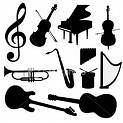
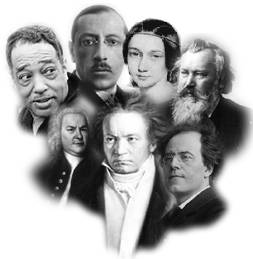

Why listen to classical music or study composers?
We’ve all heard about the ‘Mozart Effect’ in the last few years. There have been books and studies claiming that listening to the music of Mozart actually helps to develop the brain, improve short term memory, and increase IQ. Many parents have jumped on the bandwagon and are exposing their children, some even before birth, to Mozart.
There is great debate on whether or not there really is anything to this theory, but research does show that when a child listens to classical music the right hemisphere of the brain is activated, and when a child studies a musical instrument both the left and right hemispheres of the brain light up. Nevertheless, the interest generated by this phenomenon has catapulted classical music back into the spotlight, and that in itself has been a good thing.
In addition, classical music is simply beautiful and peaceful. It’s universal and no matter what language, music forges a common bond. Music also creates emotions and enriches lives with the fulfillment that comes from enjoyment. Many people believe that the soothing tones of classical music influences children’s behavior in a positive way and increases attention span and concentration. A working knowledge of classical music and the men who wrote it also makes for a well-rounded education and individual. But never underestimate the ability of a very young child to appreciate and recognize a piece of music or the work of a composer. When my son was about two years old, he would shout out, “Tchaikovsky!” whenever he heard Dance of the Sugar Plum Fairy!
The composers who made these musical contributions to the world are important in their own right and have their places in history as well. Many of them had extraordinary lives and are quite interesting to read about. Children are usually fascinated to learn things such as the fact that Mozart was a child prodigy who composed music by the age of five or that Beethoven continued to write music even after he lost his hearing. And although it’s easy to introduce our children to the composers as we expose them to various pieces of music, we can do so by casually mentioning the na
by Sharon Blumberg
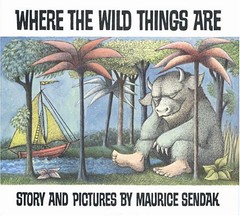
I enjoy enhancing literacy skills in Spanish and English for my seventh grade students in unusual ways. I recently use the picture book Where the Wild Things Are and emphasized certain pages that depicted key points in the story. This story was written by Maurice Sendak in1963 and, published by Harper & Row. The Spanish version was translated into Spanish in 1996, by Teresa Mlawer. Twenty-five years ago the book was awarded the Caldecott Medal, as the most distinguished American picture book for children. The book has sold over three million copies in the United States and has been reprinted into many foreign languages other than Spanish. This classic children’s tale has recently been made into a major motion picture at the Box Office in 2009, an opera, and a video game. It was also been featured in the recent motion picture, Blind Side. My bilingual presentation consists of a Spanish version, that I read and translate to English, as I point out the illustrations to my students. They insist on viewing the illustrations as I read the story in both languages.
This story is about a boy named Max who one night decides to make mischief in his home. He dresses up in a wolf costume and terrorizes his mother. As punishment, his mother sends him to his room without supper. Soon afterwards, a mysterious forest grows and overcomes his whole house. This naturally develops out of Max’s imagination. After Max becomes the “King of the Wild Things,” he becomes homesick and longs to return to his home and his own room. At the end of the story, he returns to his mother. She in turn demonstrates her unconditional love for him by bringing him his dinner. When Max finds his supper waiting for him, still warm, he knows that his mother will always be there for him.
The story marks a critical point in American literature for children. The reason for this is because it presents a child expressing his anger through his behavior and imaginations that run simply wild, to say the least. But in the end, these issues get resolved for the child, so all is well and secure with his world. Aside from the bilingual phrases and concepts of out of control mischief, anger and rage, there is something special about presenting this particular book to my students.
Some of them seem to have a far away look in their eyes as they hear the story and eye the mesmerizing, unforgettable illustrations. Who can’t relate to revisiting the world of one’s childhood imaginations and fantasies of other places? We are never too old for that. I was pleasantly pleased when one class actually applauded after I finished presenting this book in Spanish and English, along with the illustrations. Some appeared to wake up as if they had dreamed the story themselves. So it is nice to realize that “where the wild things are” is not as far away as we may think!
********
 Sharon Blumberg is a junior high Spanish teacher and a freelance writer. She has been teaching for 17 years. She currently teaches seventh grade Spanish in Illinois. She has two grown children and resides in Indiana with her husband and dog. She is an active member of The Children’s Writers’ Coaching Club and The Story Circle Network.
Sharon Blumberg is a junior high Spanish teacher and a freelance writer. She has been teaching for 17 years. She currently teaches seventh grade Spanish in Illinois. She has two grown children and resides in Indiana with her husband and dog. She is an active member of The Children’s Writers’ Coaching Club and The Story Circle Network.
by Kathy Stemke
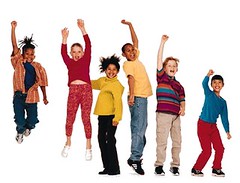
Because math concepts tend to be abstract in nature and the traditional methods of teaching math facts are boring and ineffective, introducing interactive math activities will increase the learning and retention of math facts. Students will be eager to participate in these fun-filled games and projects.
COUNTING GAME: A counting lesson might begin with a circle game similar to Duck-Duck-Goose. The students sit in a circle on the floor then one students stands behind a sitting classmate and begins counting each of their classmates in turn until they reach ten. All the students can assist in the counting. When the standing student reaches their tenth classmate the tenth classmates stands and chases the counting student around the circle attempting to tag them before they return to the place of the chasing student.
JELLYBEAN STORY: Students learn through exciting fairy tales and stories. Fun characters come to life for the students, bringing the numbers and math facts to the real world. The following tale is an example of the kind of story that can be used.
“It’s my job, said the jellybean queen, to divide the jellybeans equally among the subjects of Numeria. This bag of jellybeans is for you two girls. Be sure to share them equally.”
“But how can we be sure to share them equally between us?” Chali asked.
“Oh,” the kindly queen said, “That is easily accomplished. Watch. . . . There are six jellybeans in the sack . . . .here is one for you, Chali, and one for you Stephanie, another one for you Chali, and another one for you Stephanie, one more for you Chali, and one more for you Stephanie . . . as you see we now have two piles of jellybeans with 3 in each. It’s as simple as that!”
The girls smiled at each other.
The queen was so busy she asked the girls to help her. For the rest of the day, Chali and Stephanie busily counted and divided jellybeans.”
This story could easily be modified to teach subtraction. The students could take turns eating one or two jellybeans.
After illustrating this story on the chalkboard, go outside and hide several piles of “jellybeans” around the room. Whenever a pile is found, the student must divide them equally.
GUESS WHICH NUMBER: You can follow up this activity with a 100 board. Look for number patterns of odd and even. The students will discover that evens end with 2,4,6,8,0 and odds end with 1,3,5,7,9. Call out random numbers and the students can jump up and down for even numbers and hop on one foot for odd numbers.
BIG BALL MATH: This game requires the teacher to section off a ball into spaces with a marker. Each space houses a math problem (add, subtract, multiply, divide, etc). The children toss the ball to each other, and when they catch it, they answer the problem under their right thumb. For young children the problem can be as simple as identifying numbers or shapes, and for older children a way of practicing multiplication or division facts.
NUMBER LINE GAME: Using a number line system of number placemats across the floor, the team may deduct the answer by acting out the problem. For example. 2 + 3 = 5
Team A organizes themselves by standing on number mats on the floor. One stands on zero, while the rest stand in order from 1, 2, 3 4 and so on. For the problem 2+3, the person standing at zero may first take two steps on the first two mats and then jump another 3 mats indicating an increase of 3 in the problem to land at mat 5.
SKIP JUMP MATH: Using lighter colored vinyl, cut out shapes, (circle, square, rectangle, triangle, pentagon) number them with a marker, and tape them to the floor. The students ju
by Amy M. O’Quinn
In my last Teaching Tips column, I talked about the importance of introducing fine arts to young children. To recap that subject, here is what I wrote:
Why Study Fine Arts?
Charlotte Mason, a 19th century British educator, believed that exposing children to great ideas and beauty in all areas inspired them to greatness as well. She theorized that by letting them become familiar with the best artists, composers, and writers, they would be less willing to settle for mediocrity in themselves. As Elizabeth Gutman said in her book, The Story of Art, part of The Bookshelf for Boys and Girls series: “The magic power of art can arouse all kinds of emotions in us, from simple joy to much deeper feelings. And artists are great people whose works can gladden our eyes, enrich our thoughts, and deepen our feelings.”
I think these words can apply to ALL areas of the fine arts. And with today’s norm of following the crowd or being happy with the status quo, we should want our children to be inspired and motivated to strive for more—to reach for excellence instead of being content with the marginal.
I also introduced the topic of picture study in the last column. Now I would like to discuss the most famous bard of all time, William Shakespeare, and how a ‘Shakespeare Study’ can benefit even young children.

Why Shakespeare?
William Shakespeare ultimately helped to shape the English language. Because of him, we now have such phrases as ‘in a pickle,’ ‘all’s well that ends well,’ ‘love is blind’, ‘wild goose chase’, and countless others. In fact, Shakespeare is credited with coining or creating close to 2000 words and phrases that are now part of our daily usage. In addition, his language is challenging, with tight and concise sentences. Vocabularies are sure to be increased when reading Shakespearean plays or poetry. And most of all, Shakespeare was a master of plot and a great storyteller of history. He knew the Bible and mythology, and drew from both, and it is evident that his writing was definitely influenced by Christianity. I’ve often heard that if a person is familiar with the Bible, mythology, and Shakespeare, he will always have a greater understanding of any literature as well as human nature. Ideas of greed, love, hatred, self-loathing, pity, generosity, courage, and even misunderstandings are ageless.
Why Start Young?
If a child is introduced to Shakespeare early, he will not be apprehensive about studying the plays when he is in high school. When he is young he will certainly not understand all the twists, turns, and nuances that Shakespeare employs, but he can most definitely read simplified versions and keep track of the basic plot and characters and learn the ‘stories’ behind the plays. When he is older, he will already have a basic understanding of Shakespeare’s work and be able to build upon that foundation with a deeper understanding of the plots and the moral and historical significances. He will recognize within the characters a mixture of sinfulness and goodness—just as we all are in real life. He will see weaknesses and strengths in the players within the layers of each story.
Beginning:
Children around the age of six might enjoy Beautiful Stories from Shakespeare for Children by E. Nesbit, author of the Railway Children. Ms. Nesbit retold twenty of Shakespeare’s dramas in story form to make them more accessible to a younger audience, which is the perfect introduction to the bard for children.
The next step up might be Tales From Shakespeare by the brother/sister team of Charles and Mary Lamb. Published in 1807, this book includes all of Shakespeare’s most famous comedies and tragedies. The tales are retold in a cl
by Renee Kirchner, Teaching Tips Contributing Editor

People all over the world celebrate Christmas, but not everyone celebrates the same way. Many of the traditions in the United States originated in other countries. Listed below are common customs and traditions of many different countries. See if you can find the traditions followed by your family and find out what country they came from. You might even find a new tradition or two that you and your family would like to add to your celebration this year.
Norway
In Norway, the children are sent outside or next door while the adults decorate the Christmas tree. When the children return and see the tree for the first time it is fully decorated with presents underneath. Imagine how happy they must feel when they see the tree. The family then joins hands and stands around the tree singing Christmas carols.
Australia
In Australia, Christmas is celebrated during the middle of summer. They do not have a white Christmas like many parts of the United States. Australians like to eat their Christmas dinner outside and then go to the beach for family fun.
Britain
In Britain, children write letters to Father Christmas asking for Christmas presents. Instead of mailing their letters to the North Pole, the children toss their letters into the fireplace and they float up the chimney to the North Pole. Sometimes the lists catch on fire. If that happens, the child has to write another list.
Mexico
In Mexico, children leave shoes out for Santa rather than hanging stockings by the fireplace. On Christmas Eve, singers parade throughout the towns carrying bells and candles on long poles. The parade ends at the local church where everyone attends a Christmas service.
Hopefully this gave you an idea of how children in other countries celebrate Christmas. Maybe you would like to follow one of these traditions this year.
Here is a holiday craft to get you in the spirit.
Puzzle Wreath Ornaments
Supplies:
Cardboard
Puzzle pieces from old puzzles
Glitter
Ribbon
Scissors
Glue
Give each child a small ring cut out of cardboard. Staple a small piece of the ribbon to the top of the ring in a loop. This will be for hanging the ornament later.
1. Have child glue puzzle pieces to the cardboard ring and ask them to cover every part of it.
2. Ask them to put a few dots of glue on top of the puzzle pieces.
3. Let them sprinkle glitter on the glue.
4. Shake off excess glitter from wreaths.
5. Hang wreaths on a Christmas tree.
No Tags
I’ve been wondering how we authors can help teachers use our books. This, of course, requires that we learn more about what teachers actually do with our books in the classroom. So I created a questionnaire and Cheryl Harness gave it to Carol Hutchens, a teacher friend at Mountain View Elementary in Windsor, CO who went to the trouble of filling it out. The results are below. My questions are in boldface. Carol prefaces her responses as follows:
I'm a special education teacher for grades 3-5. I primarily work with 4th and 5th graders, teaching reading, writing and math in "core replacement" groups. Explanation: all of our 4th graders have reading at the same time, so the group I have is getting "core replacement" in my room at the same time their peers are being taught reading in the general education classroom. Same with math, writing and 5th grade reading. My school also has a literacy teacher (for students who are doing a bit better than mine academically) and a Title 1 reading teacher.
What kind of reading assignments do you give kids? In class, we all read the same story/book together. Sometimes, I'll let the kids read silently to themselves or in pairs, but this is usually not very effective because of their lack of reading skills.
How important do you feel it is for every kid in your class to read the same assignment on a topic? For my kiddos, this is very important. This way, I can be assured they are reading correctly, and we have wonderful discussions to ensure comprehension of the material. Most of my kids are way better verbally!
Do you feel you MUST teach from the textbook? Unfortunately, yes. If so, why? District  requirement. But, I supplement a lot in my classroom by reading non-fiction books at the beginning of each reading class (the kids love books by Cheryl Harness!) and also by pulling in additional non-fiction books to support stories we're reading. (ie: 5th graders are reading a story about cowboys that mention Nat Love, an African American cowboy. He wrote a book about his experiences and I found it online. I copied it and shared selections of it with the kids - they loved it!)
requirement. But, I supplement a lot in my classroom by reading non-fiction books at the beginning of each reading class (the kids love books by Cheryl Harness!) and also by pulling in additional non-fiction books to support stories we're reading. (ie: 5th graders are reading a story about cowboys that mention Nat Love, an African American cowboy. He wrote a book about his experiences and I found it online. I copied it and shared selections of it with the kids - they loved it!)
Have you ever gone to the library and looked for books on the content you have to teach? Honestly - I usually hit half.com or ebay first. I like to purchase books with my own money, then I'll have them for the next years! I have quite a collection of books in my classroom and like to have them "at my fingertips" to pull for kids!
Have you ever used a trade (library) book on a subject covered by your textbook instead? Yes. If so, why? Usually because the story provided in the book I'm required to use doesn't go "in depth" enough about the subject. Also, I like to show my students that each and every book about a subject can offer different/additional information! For instance - my students are stunned to know that I personally own more than 50 books about Lewis and Clark.
How closely do you coordinate what you are teaching with your school librarian? H
by Sharon Blumberg

Although I’ve been a Spanish teacher for many years, this year I am also teaching language arts. I love watching my students discover connections to themselves in the reading and writing activities that we work on together. Within the required curriculum are some areas of free choice that tie in well within the course.
One activity that my students can respond to with a nice level of differentiation is responding to journal prompts. With this kind of writing activity, every student’s response is unique. However, I don’t have students do this activity too often or it loses its effectiveness. I have them respond to journal prompts either once a week or even less.
The journal prompts work in the following way: I give my students an idea which is referred to as a prompt. For this particular activity, I don’t emphasize spelling or grammar during the writing. Even though I make corrections when I read them, these don’t count against the students’ grades. For example, starting with Thanksgiving, which can carry over to the winter holidays of Christmas, Chanukah or Kwanza, I ask my students to “Write about something that you are grateful for. Write at least four complete sentences explaining this. How do you express gratitude for what you are grateful for?”
It is fascinating to read the varied ways my students express themselves. They do a nice job of demonstrating the many different things that they are indeed grateful for.
After about five to ten minutes of writing, I give them the option of reading their responses to these prompts out loud in order to get class participation enrichment points. After the students share their writings with the class, I have a student helper collect the writings as part of their classroom jobs, and turn them in. After I read through their journal prompt responses on my own time, I make comments based upon what they wrote. In this way, I am creating a safe way to dialogue with my students on a more personal level. Some students write more than others, depending on the prompt I give them.
Occasionally, some students may say they don’t really know what to write about. If this happens, I give them an alternative prompt, or ask them to pick out their own topics as writing prompts. For example, “What was the best part of your day today, or what was the least favorite part of your day today, and why?”
The above kind of prompt usually evokes some kind of writen response. Journal prompts bring out many kinds of memories as we connect with one another. It is also a great way to evoke holiday sentiments. This will be a year of great discoveries as my students and I embark upon new vistas.
******************
 Sharon Blumberg is a junior high Spanish teacher and a freelance writer. She has been teaching for 17 years. She currently teaches seventh grade Spanish in Illinois. She has two grown children and resides in Indiana with her husband and dog. She is an active member of The Children’s Writers’ Coaching Club and The Story Circle Network.
Sharon Blumberg is a junior high Spanish teacher and a freelance writer. She has been teaching for 17 years. She currently teaches seventh grade Spanish in Illinois. She has two grown children and resides in Indiana with her husband and dog. She is an active member of The Children’s Writers’ Coaching Club and The Story Circle Network.
No Tags
by Amy M. O’Quinn
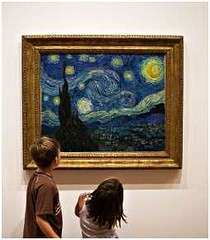
Classical music. Art Appreciation. Nature Study. Poetry and Shakespeare. These areas of study may sound like complicated courses that are best left alone until the high school or college years, but young children can certainly benefit from an acquaintance with the fine arts as well. As parents, we all want our children to be well rounded and educated to the best of our abilities. We expect teachers (or ourselves if we homeschool) to cover the basics such as reading, writing, and arithmetic, but there is also something so satisfying about recognizing a Monet or a Cezanne, or hearing and identifying music composed by Mozart or Tchaikovsky.
There is joy in taking a walk, finding a special leaf to sketch in a nature journal, and later discovering in a field guide that it belongs to an aspen tree. And who hasn’t heard or read a common phrase (such as green-eyed monster) that can be traced back to the pen of William Shakespeare?
Why Study Fine Arts?
Charlotte Mason, a 19th century British educator, believed that exposing children to great ideas and beauty in all areas inspired them to greatness as well. She theorized that by letting them become familiar with the best artists, composers, and writers, they would be less willing to settle for mediocrity in themselves. As Elizabeth Gutman said in her book, The Story of Art, part of The Bookshelf for Boys and Girls series:
“The magic power of art can arouse all kinds of emotions in us, from simple joy to much deeper feelings. And artists are great people whose works can gladden our eyes, enrich our thoughts, and deepen our feelings.”
I think these words can apply to ALL areas of the fine arts. And with today’s norm of following the crowd or being happy with the status quo, we should want our children to be inspired and motivated to strive for more—to reach for excellence instead of being content with the marginal.
In my monthly contribution to the “Parenting and Teaching Tip” column over the next few weeks, I’d like to explore some of these areas in more depth. But for this particular column, I will focus on “picture study”, which is one facet of art appreciation.
Picture Study
Introducing a new artist or a specific piece of art is very easy to do. Many websites have lists of suggested artist rotations, but it’s better to choose one artist’s work to study at a time so the child can become familiar with the style and at least four of his/her pieces of artwork. My twelve-year-old son recently studied the work of Mary Cassatt, and he can now easily recognize her paintings.
We began our study of Mary Cassatt by reading more about her life in a biography. Then I had him focus only on her painting, Children On the Beach (1884). I let him study the picture for several minutes, then I turned it over and asked him to describe what he remembered about the painting, even the little details. Afterwards, we turned the picture back over to see how well he’d seen it all in his ‘mind’s eye.’ We talked about the medium used, the colors, the subjects, etc. We did this for several days, and each time he remembered more and more about the painting. On another occasion, I had him try to re-create the painting himself from memory. Although not a natural artist, he did quite well! We went on to study three more of her paintings before moving on to a new artist.
On another note, I had a large framed poster of Children On the Beach hanging in my children’s bathroom. When my little ones (ages 2 and 4) took a bath, we would look at the painting and talk about it. It’s amazing how much they learned about Mary Cassatt’s work in just a few minutes each night! They remembered almost as much as their older brother, and it was just that simple.
Some people choose to make artists t
Somehow October’s chorus about using our books in the classroom didn’t come everyone's way on the guitar until November, so kindly bear with me for a minute while I wrap up my part of this song with one last verse.
I hated history when I was a kid. The way we were supposed to learn everything was by memorizing a bunch of boring names and dates and battle sites. To me, the people in history were a lot like George Washington on the dollar bill; old and green and wrinkled and dead.
What a waste! The real George Washington wasn’t anything like that portrait. Just between you and me, our boy George was a stud. He was so tall that most other men only came up to his shoulder. He was a great athlete and his hands and feet were enormous—what a basketball player he might have made! This terrific horseman, dancer, and card player was also so fearless in battle that even when his horses were shot out from under him and bullets ripped through his coat, he never left the front lines. You can’t make this stuff up; it’s all true, and if I had known things like that about the dead people in my history books, well of course I’d have wanted to hear more.
So how can teachers make history spring to life for kids? Here are three of the ways.
1) The Storyteller’s Voice- One of the main reasons that so many stories from history are still around is that they’re really the best stories of all time. I hated history because all those moons ago, my own teachers didn’t know how to tell a great tale. But if teachers can teach by using a storyteller’s voice, you can bet your boots that kids will beg to listen in. The best nonfiction books can show you the way and can add in fabulous pictures to boot. (And forgive me for mentioning that our INK THINK TANK has these books in spades.)
2) Tie-Ins- If you can get kids to relate directly to something in a book about history, you’ve got it made. Here are some examples from my book talks—no reason why with a little extra imagination teachers can’t do this kind of thing too. In one school, the students put on a wonderful play about Lewis and Clark based on my book How We Crossed the West and invited me to watch. When I visited their classrooms the next day, I surprised each actor and actress by telling them some incredibly happy and sad and funny things that happened to their own characters after the journey ended. This new information was a huge hit. When I presented the same book another time, we were able to bring a real Newfoundland dog (like Seaman, the one Meriwether Lewis brought on the journey) into the room. Bingo! I got to tell about all the funny and even life-saving adventures the dog had on the trip. Trust me—dogs are attention grabbers all the way. And during a previous Presidential election, an older group did a great job of comparing the gigantic role propaganda played in promoting George Washington vs. King George III back in Revolutionary times with the role propaganda played in that particular presidential election.
3) Lights, camera, action!- Younger audiences like nothing better than to sing, laugh, make funny noises, and wear costumes. As it turns out, these qualities are great tools for teaching history too. I love to use my book The Old Chisholm Trail; A Cowboy Song as a fun intro to those famously difficult cattle drives from the wild west. Very Short Version of how this works: I dress up as a cowboy and briefly explain how hard that trip must have been. Then I invite 3 volunteer cowboys onstage, where they don huge paper moustaches, and I give 3 more volunteers stuffed longhorn cattle to hold. As I (badly) sing funny verses from the real song, the cowboys and cows make appropriate cowboy and cow sound effects when I point to them after each verse, and the audience sings the chorus in their turn. It is hilarious, it’s the BEST teaching tool, and it all comes from a book. Try it!
View Next 16 Posts











.jpg)



















 0 Comments on A Look at Lady Liberty as of 1/1/1900
0 Comments on A Look at Lady Liberty as of 1/1/1900






 <
<


























Good morning, April! I met Alexis at an SCBWI conference years ago. She's a joy to be around, and that shows in this interview! Looking forward to checking out her book. What a great topic.
Wow, April, this post is chockers! I suspected by the post's title it would be filled with good stuff... it certainly didn't disappoint. Thank you for introducing me to Alexis! I am enchanted by the trailer of her new book and humbled by the Great Falls depicted in her poem.
Hi there April, thank you for sharing this detailed interview with Alexis. I confess I haven't read any of her books yet, but your interview just makes me want to grab one of her books right away. I love teaching authors and her advice for kids to just make a mess and to find the seeds of ideas from there. Lovely! :)
After reading this post, I can see why Alexis should always wear that crown. What a multi-talented dynamo!
Enjoyed her poem and hearing about her new book. :)
Thanks for the informative post and the great giveaway. Yet another piece of history of which I was unaware. I think the kids will really enjoy this one, thanks!
Wow, what a lot of accomplishments by Alexis. Niagara Falls has a fascinating history, so I'm sure this new book will be good. Thanks!
Thanks for this great interview, April and Alexis, and for sharing the poem. I especially liked these lines:
>>I gnaw at rock
bite through cliffs
claw the very bed
across which I race
oceanward.<<
I'm looking forward to reading the book!
Way to go Alexis! I look forward to reading the book.
Kathryn Hunley
We live but 30 minutes from Niagara Falls, and this poem is true true true! So perfect. I can't wait to get the book, and man I wish I was in a class taught by Alexis too. Thank you for this rich post!
What a very fun, vibrant and accomplished person. That poem is fabulous! Thanks April and Alexis.
Thankk you for this wonderful interview - and for sharing both the book trailer (I must have tis book!), and the poem, which I can't wait to share with my students.
Wonderful post! I want to win this giveaway! My colleagues and I are leading 6th grade students in a year long enrichment project and this year's theme is bridges. We have been discussing metaphorical bridges as well as actual bridges. This book would be a great bridge for that purpose! Count me in!
Thank you for introducing me to the dynamic Alexis. Love the Niagara Falls poem and history!
It was nice to "meet" Alexis...I've always loved the story of Homan Walsh and Niagara Falls! The text and the illustrations are lovely.
I enjoy the variety of information on Teaching Authors. Thanks for sharing :)
Excited to read this nonfiction!
So true about water! It's one of the strongest forces on earth! I like the poem.
I am so looking forward to reading this book. I've been working on a historical MS myself and could definitely use this as a mentor text. Alexis is so kind to beginning writers. I remember her asking me, "What are you working on?" when she signed RECESS QUEEN for me. When she found out I write nonfiction, she gave me lots of great information. Kirsten Larson